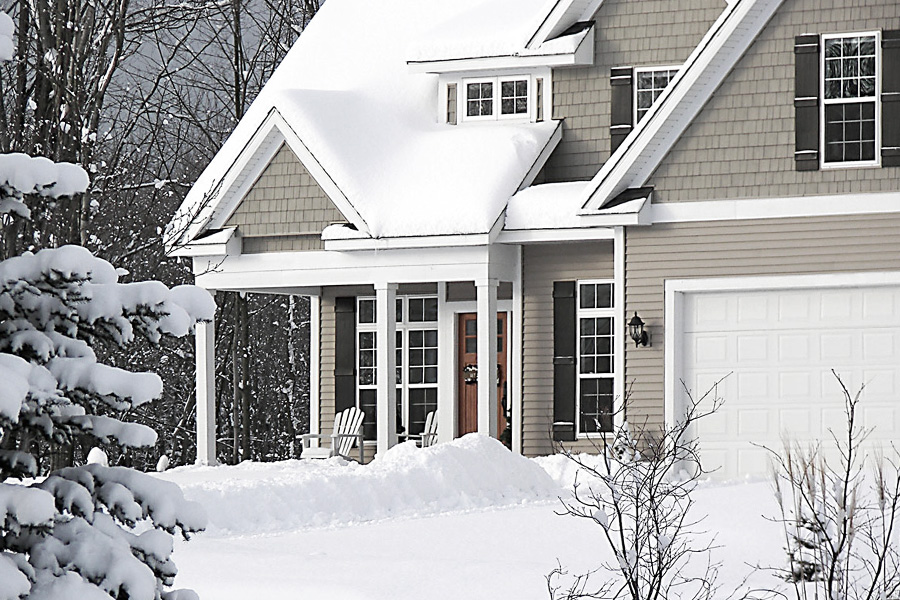Can you replace a roof in the winter? Is that even possible during the winter months, when temperatures drop and snow covers everything? The answer is YES! While it may seem counterintuitive to tackle such a project during the colder months, there are several reasons why it can be a smart decision.
In this post, we will discuss everything you need to know about roof replacement in winter. We will cover the advantages and challenges of winter roof replacement, and highlight the importance of hiring professional contractors for the job.
So sit back and read on to learn more about replacing your roof during the winter months!
Winter Roof Replacement Advantages
Today’s modern roofing materials and techniques are designed to be installed in extreme temperatures.
Working with an experienced local roofing contractor who understands the necessary precautions and techniques for working in such conditions is a must. They will know how to properly handle the materials, ensure proper preparation, and take the necessary installation techniques to ensure a successful project.
Quicker Availability
Typically, scheduling a roof replacement in the spring or fall can take several weeks due to high demand. However, during the winter months, the time between the estimate appointment and the actual roof replacement is usually much closer together. This is because roofers tend to have a lower workload during this season compared to the busier spring and fall periods. Many homeowners find this quick turnaround time during winter quite appealing and convenient.
Whether it’s a small repair or a complete replacement, taking advantage of the slower season can ensure that your roofing needs are taken care of promptly and efficiently.
Potential Cost Savings
During the winter months, when the demand for roof work tends to decrease, some contractors may offer discounts and special offers to attract customers. While this is not always the case, it is worth checking with local roofing companies to see if any seasonal specials are available. Taking advantage of these offers can help you save money on your roof repair or replacement project. However, it’s important to remember that quality should never be compromised for cost savings.
Always ensure that you hire a reputable and experienced roofing contractor who can deliver excellent results regardless of the time of year.
Before The Rain
With spring time kicking off heavy showers throughout most of the country, investing in a new roof before it arrives is a wise decision for homeowners. A sturdy and reliable roof is essential in protecting a home from water leaks and damage caused by heavy rain. By replacing the roof ahead of spring, homeowners can avoid the headache and expense associated with water leaks, which can lead to structural damage, mold growth, and costly repairs.
It is a proactive measure that ensures peace of mind and preserves the integrity of the home.
Less Risk To Landscaping
A roof replacement is a significant project that requires careful consideration and planning. While we understand the importance of protecting the lawn and property of each house we work on, there is always a risk of damage occurring. However, there are certain times of the year when the risk is minimized. Winter, for example, is an ideal time for roof replacements because lawns are typically dormant and bushes aren’t in bloom.
This makes it easier for us to take extra precautions and ensure that your property remains protected throughout the process.
Sealant Bond
One of the major advantages of replacing your roof in the winter is the stronger bond that can be achieved between your shingles and roof. This particularly applies if you opt for asphalt shingles, as the sealant used for these shingles bonds better during the winter months than in the summer.
Winter Roof Replacement Challenges
Unpredictable weather conditions and colder temperatures can have a small impact on the roof replacement process, but with proper preparation, these challenges can be overcome.
Weather
It is crucial for roofing contractors to closely monitor weather forecasts and proactively plan their schedules accordingly. Unfavorable weather conditions can greatly impact the progress of roofing projects, leading to scheduling conflicts and delays. By staying updated on weather forecasts, contractors can anticipate potential disruptions and make necessary adjustments to their work plans.
This includes rescheduling installations or repairs during periods of stable weather, ensuring that the project can be carried out efficiently and effectively.
Material
Cold temperatures can pose challenges for roofers when it comes to installing roofing materials. The cold weather can make these materials more brittle and less flexible, which can affect the installation process. However, experienced roofers are well-prepared to handle these challenges.
They have developed techniques and utilize specialized tools to mitigate the effects of cold temperatures. One such technique is the use of warm air blowers, which help soften the materials and improve their flexibility. This ensures proper adhesion and a secure installation, even in colder climates.
Tools
The freezing temperatures can have an impact on the nail guns used during the roofing process. Nail guns rely on compressed air, and when there is humidity in the air, it can turn into water and freeze in the airlines. This can reduce the flow of air that drives the nails, increasing the risk of improper nail placement.
It becomes crucial for roofers to pay extra attention to ensure that shingles are securely installed. This means carefully monitoring the placement and depth of each nail to avoid underdriven or overdriven nails.
While it may require additional effort and attention, with proper precautions and care, a successful roofing job can still be achieved even in cold weather conditions.
Safety
Winter roof installations can be a treacherous task due to the hazardous conditions brought on by rain, snow, and ice.
Slippery surfaces pose a significant risk to the safety of the roofing crews, making it imperative for them to take extra precautions. The use of fall protection equipment becomes essential in such situations, ensuring that workers are secured and protected from potential falls.
Moreover, in certain cases, it may be necessary to wait for the morning frost to melt before commencing the work, minimizing the risk of accidents and injuries. Similarly, if heavy snow or ice accumulations are present, it may be prudent to postpone the installation until these elements have melted away.
By prioritizing safety and exercising caution, roofing crews can successfully navigate the challenges presented by winter conditions and complete their work with minimal risks involved.
Replacing Your Roof in the Winter
Replacing a roof in winter is possible but comes with its own set of challenges. It is important to understand the realities and advantages of replacing your roof in the winter. While cold temperatures, wind, and snow pose challenges, there are ways to handle them and prevent shingle damage.
The quality of work during winter can be maintained by using effective sealants and ensuring timely completion.
Hiring professional roofing contractor is highly recommended for a successful replacement.

















